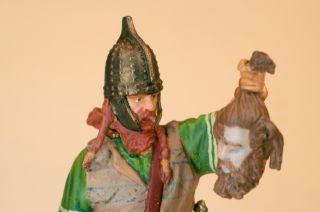
 |
The La Tene period is named after "the shallows" of Lake Neuchatel in Switzerlandwhere many Celtic artifacts and religious offerings where found.In the fourth century B.C. the Celts were flourishing throughout central Europe.In fact in 390 B.C. the Celts sacked Rome and the Celtic leader Brennus demandedhis weight in gold as a tribute.Some say the Romans never forgave the Celts for this defeat.The Romans under Julius Caesar and Hadrian devastated the Celts in later years.
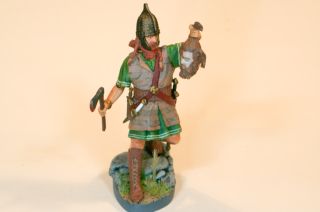 |
Although the box says 54 mm scale, this figure is really about 65 mm from the solesof the feet to top of the skull.So this figure will work as a display piece, but will not work as a figurefor miniature wargames unless you want a giant ogre of a Celt on one team.
The La Tene period is one of great artistic advancement for the Celts.Long before reaching Great Britain, the La Tene Celts developed theswirling, twisting, intertwining style that is very popular Celtic art today.Also great metal jewelery, weapons, and armor were sought and traded for centuries.
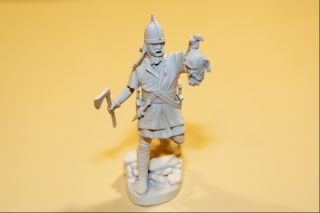 |
It is recommended that you drill small holes and place pins toattach the hands.I recommend this after knocking off the left hand with the severed head fourtimes!Notice the rather dynamic pose is leaning forward to the edge of the base.If you knock the figure forward, the rather heavy model lands directly onthe severed head, and in my case cracking the super glue at the left wrist.Once pinned and glued, the wrist can support the entire weight of the model (and then some).
After the La Tene period came the great migrations of the Celts.They traveled from central Europe north to Great Britain,west to Spain, and east to Greece and Turkey.The Turkish capital of Ankarra is situated on the site of anancient Celtic hill fort.
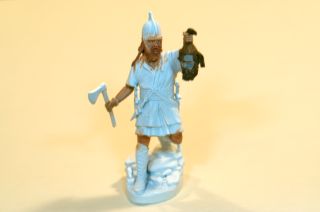 |
Celtic helmets were known for their cheek guards and fancycrests.One Celtic helmet from Ciumesti has a metal bird with articulated wings.The wings flap up and down as the wearer runs or ride a horse.
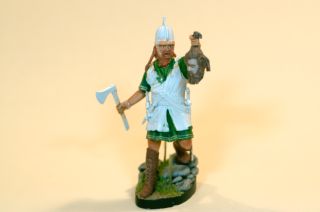 |
My second recurring problem with this figure was chipping of the acrylicpaint.I must have gotten some finger oils on the primed figure.The hair and base paints kept flaking offas seen at the base of this miniature.I guess part of the problem is that the miniature sat for 6 months in its primedstate waiting for me to complete other projects.
The Celts were also masters of textiles.Although no dyed garmentssurvive, we know from historical texts that Celts lovedchecked, striped, and plaid patterns.
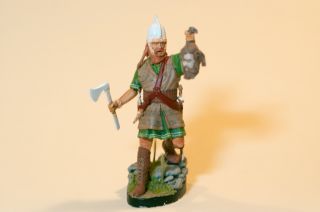 |
Most of the Celts of France and Germany lived in rectangular houses.Celts of Britain and Spain lived in round houses.Many archaeological sites have mapped out Celtic villagesites, and it is relatively easy to see the village layoutfrom the remnants of walls, fire place hearths, and post holes thatstill exist to this day.
 |
The La Tene period occurred during the Bronze Age, and therefore this Celt has a bigbronze helmet.This is before the Iron Age when ancient people discovered how to make furnaces andfire hot enough to melt iron.Also scale armor was available, but not mail armor.People had not yet discovered how to make wire for mail rings.
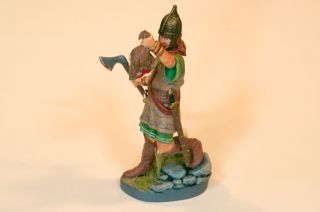 |
One question that has stayed with me since childhood is"do you paint blood on your miniature's weapons?"When I was younger, I always did.Now almost every weapon I paint is clean and blood free.Since this figure gazing into the face of his enemy, I thoughtit would be good to paint blood on the axe and the victim'sneck to reflect the victorious moment in the battle.
 |
 |
I hope you enjoyed reading the details of the paintingand photographing of a large miniature of a Celt from the La Tene period.Perhaps these hints will help you get a head in painting ancient warriors.More miniatures-related articles are atDan Becker's Miniatures and Models site.Thanks for stopping by and reading about my miniatures.